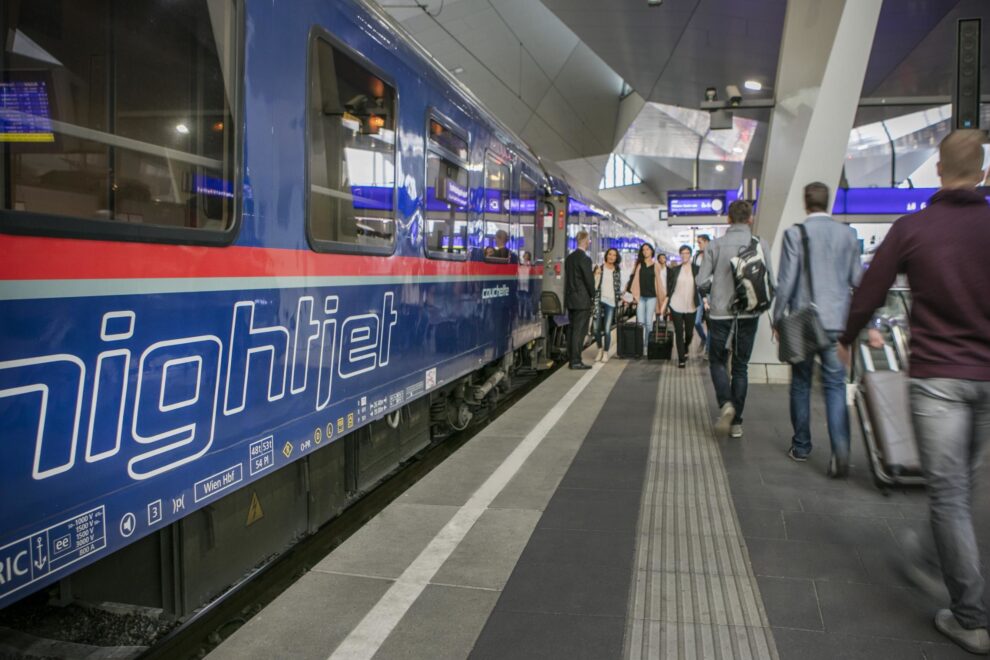The Paris-Vienna night train has sold 70 percent of all available tickets since it launched in December 2021 – practically a full house for each of its three weekly return runs. The Nightjet service, run by Austrian national provider OBB, pulls out from Paris’ Gare de l’Est at 7:30pm and arrives in the Austrian capital Vienna at 10am the following morning, with the cheapest tickets starting at just €29.90. It is one of many new lines that have opened across Europe reconnecting major cities with direct train routes – and more are on the horizon.
Italian provider TrenItalia hopes to launch a direct Paris-Madrid line by the end of 2024, following what it describes as the “incredible” success of its lines connecting Paris, Lyon, Turin and Milan that were launched in 2021.
A sleeper train between Paris and Berlin is scheduled to start running at the end of 2023, along with a new high-speed connection between the two capitals launching in 2024 that will reduce the current 10-hour journey time down to seven.
Interest in long-distance rail travel has been growing steadily for the past eight years, says rail expert Mark Smith, the owner of the train travel website seat61.com. Now, he says, growing numbers of train travellers have two main motivations.
“They’re fed up with the airport and airline experience, and they want to cut their carbon footprint,” Smith says.
National markets
The environmental arguments for train travel are compelling. A two-hour flight from Paris to Vienna results in 419.6kg of carbon emissions, compared with 41.5kg when travelling on the Nightjet, according to OBB calculations.
But there is a lack of political action to prioritise the eco-friendly mode of transport. Although a French law introduced in May banned short-haul flights on environmental grounds if there was a rail alternative that took less than two hours, the law had so many loopholes that only three routes were impacted.
It is still possible to fly from Paris to Lyon or Bordeaux, even though high-speed rail equivalents exist, and it is relatively cheap to do so. A 2023 Greenpeace report found that train tickets on cross-border routes in Europe are on average twice as expensive as flight tickets, in part due to tax exemptions granted to airlines.
It was the rise of budget air travel in the 1990s that introduced the idea of quick, cheap trips that could fit into a weekend and wiped out Europe’s night trains, which were largely considered unprofitable. In the interim, air travel has become more onerous. The 9/11 terrorist attacks in 2001 dramatically increased the demands of airport security around the world, along with wait-times in airports for travellers.
“Former head of SNCF Guillaume Pepy said that in the years after 9/11 the magic three hours, which is the journey time by rail at which you can compete head-to-head with air, had become four or even five hours,” Smith says. An hour-and-a-half flight between Paris and Nice, for example, was no longer much quicker or more convenient than a five-and-a-half-hour journey by rail, especially factoring in the city-central location of train stations and generous luggage allowance on trains.
Twenty years on, Smith says, “trains can now have power sockets and Wi-Fi so you can work on them for business travel, and if you’re looking at leisure travellers who are not rushed, they’re willing to travel even further”. That’s not to say long-distance train travel in Europe is always straightforward. Crossing one or more international borders by train can mean booking via multiple different national rail providers, and accepting that individual insurance coverage applies to each leg of the journey.
Routes and pricing are often defined by local markets, says Jon Worth, who runs the Cross Border Rail project investigating train links between European countries.
“The railway industry in Europe is still heavily national, and they think predominantly about the services they will run in their own national markets,” he says.
Grassroots support
The direct line connecting Paris and Barcelona epitomises many of the benefits and drawbacks of travelling Europe by train. A six-and-a-half-hour journey links the two city centres, thanks to hundreds of millions of euros of European Union funding to upgrade the track to a high-speed route.
Travellers can pick up a croissant for breakfast in the French capital, stroll to Gare de Lyon station and emerge at Barcelona-Sants in time for a tapas lunch in the Mediterranean sun. At least, if they can get a ticket. “In many parts of Europe you have infrastructure, which is in decent or very good condition, but in some places it has very few trains running on it,” says Worth. The Paris-Barcelona line is, he says, “chronically underused”.
French provider SNCF runs just two fast trains per day with the most expensive tickets reaching a profitable €250 for a one-way journey. On the same route, dozens of flights run day and night for a fraction of the price. And yet, the trains nearly always run at high capacity, especially during summertime, when seats sell out months in advance.
The same is true on the Paris-Vienna sleeper line, where – almost two years after the route was introduced – most berths are snapped up as soon as they are released for sale. Increasing demand for train travel “certainly hasn’t come from government and it certainly hasn’t come from train companies. It’s come from grassroots,” says Smith.
In 2022, Interrail (a combined pass which allows travel on almost every train in Europe) saw their highest-ever sales, 50 years after the ticket was first introduced. Building supply to match soaring demand is likely to be slow, Smith says, but there are hopeful signs.
In France, Spanish provider RENFE is looking to re-enter the Paris-Barcelona route, which would likely drive down prices, as on the existing seven-hour Paris-Milan connection, where competition between SNCF and TrenItalia keeps ticket fees comparable to low-cost flights.
Austrian National provider OBB – the current leader in the European field – has expansion plans that include new routes and new sleeper-cars, which are in short supply throughout the continent. More sleeper carriages will likely mean a fortified schedule. There is already talk of the night train between Paris and Berlin being increased to run on a daily basis.
New private companies such as European Sleeper and Midnight Trains are also entering the European market. The remaining piece of the puzzle is political will, says Worth, the expert from the Cross Border Rail project.
“Transport is the only sector of Europe’s economies where CO2 emissions continue to rise,” he says. “We’re all conscious that we ought to take the train to go on holiday rather than flying, but the bit in the middle – making political wind out of how to make that happen – that’s where it falls down.”
Source: Finance 24











